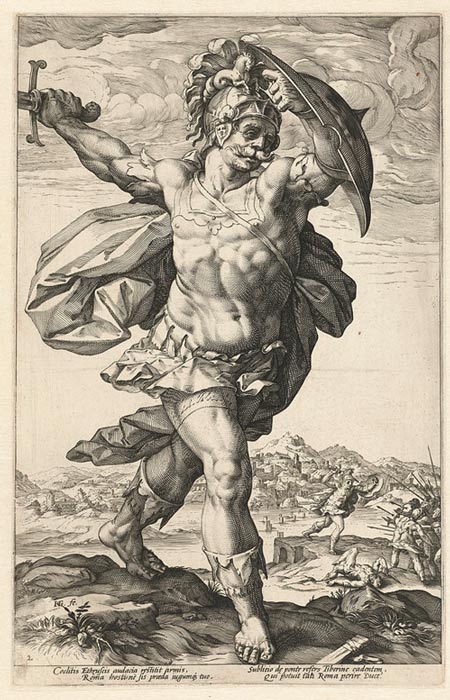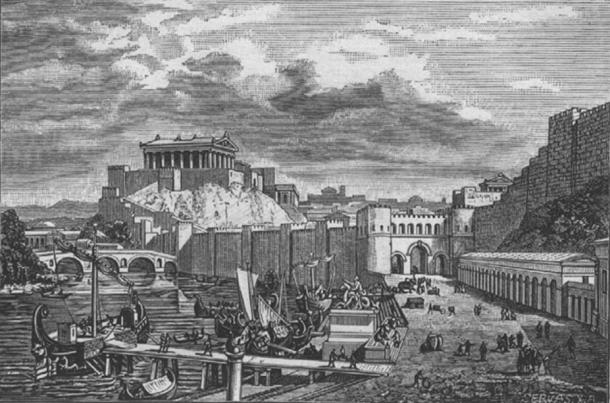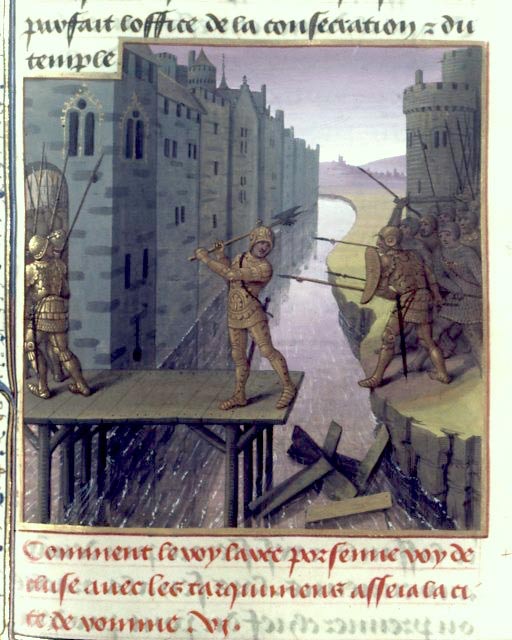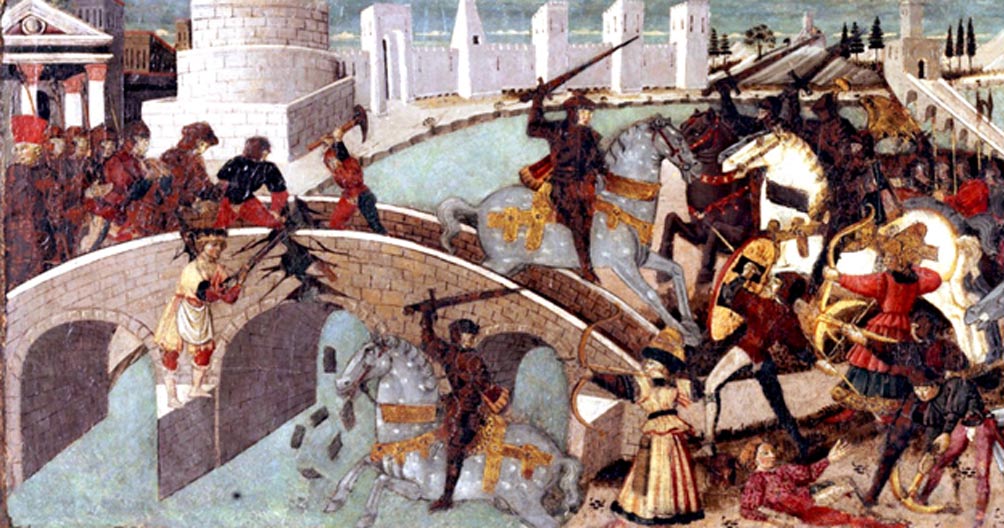The Story of the Brave Horatius Cocles, One-Eyed Hero
Through the centuries there have been many brave men who wrote their name in history with blood. One of these men was the glorious Roman Publius Horatius Cocles, a young officer in the army of the Roman Republic. His name went down in history as synonymous of bravery and sacrifice, which he showed during the battle of Pons Sublicius Bridge in Rome, Italy.

Horatius Cocles, a 1586 engraving by Hendrick Goltzius. (Public Domain)
Attack on Rome
The story begins in 509 BC with the exile of the last monarch of Rome, Lucius Tarquinius Superbus who reigned from 535 BC until the establishment of the Roman Republic. After a series of failed attempts to regain the throne, the deposed king sought assistance in Clusium, an Etruscan city.
As Lucius Tarquinius Superbus was of Etruscan ancestry, the powerful king of Clusium, Lars Porsena promised to conquer Rome in his name. It is not clear what spurred Lars Porsena to lead his army against Rome: his altruism to restore the last Roman monarch to the throne, or his own personal ambition of prevailing as the king of Rome. Whatever the reason, Lars Porsena and the Etruscans marched against the Romans in 508.

Lars Porsena was an Etruscan king known for his war against the city of Rome. (Public Domain)
Porsena concentrated his forces on the Etruscan side of the Tiber and assaulted the Janiculum, a hill in the western part of the city that lay outside its boundaries. The horrified Roman recruits, with all their resources, were an easy win for him.
- Oldest Roman Military Camp discovered in Italy was Built to Fend off Fierce Pirates
- Marcus Vipsanius Agrippa: Statesman, General, and Friend of Augustus
- The legendary Spartacus: Gladiator and leader of slaves against the Romans – Part 1
More confident than ever of impending victory, Lars Porsena and his numerous armies headed for the Pons Sublicius, one of the bridges over the Tiber leading into the city, while an Etruscan garrison was left behind to hold the hill.

Drawing of the site of the Pons Sublicius (falsely shown as a pier). Illustration of Rome during the time of the Republic. (Public Domain)
The Battle
As his troops were rushing towards the Pons Sublicius, Porsena found there a Roman line of battle across the bend of the river. Without second thought, and boosted by a sense of superiority because of his many men, he drew up a line of battle opposite it.
The Etruscan king was in command of the Etruscan soldiers at the center, while the Tarquins were in command of the Etruscan army on the left wing, and Octavius Mamilius, the son-in-law of Lucius Tarquinius Superbus, commanded the rebel Latins on the right wing. The Roman troops stood arrayed under the command of Spurius Lartius and Titus Herminius on the left wing, while the Romans consuls Marcus Valerius Volusus and Titus Lucretius Tricipitinus were in charge of the right wing.
Etruscan power devastated the opponents’ lineup and the fact that the two consuls, Valerius and Lucretius were carried, wounded off the field in full view of their troops, gave the Romans the final blow. The remaining army, struck by panic, looked for salvation toward the gates of the city, and ran for the bridge. Taking advantage of their victory, the Etruscans slaughtered among the troops milling around at the entrance to the bridge, but then began to mingle with them in hopes of crossing.
Meanwhile a young noble officer, who was on guard at the bridge, saw the Janiculum hill taken by a sudden assault and the enemy prevailing without hindrance against the weak Roman forces. In a desperate move to stop the disorderly retreat of his fellow soldiers, he reproached one after the other for their cowardice and tried to convince them that their fleeing would be in vain and would lead only to their deaths. However, his words did not hold long enough to inspire new courage in them and the young officer was left alone among the enemies. His name was Publius Horatius Cocles.
Standing to the Last
He was a patrician and a junior officer of unspecified rank who had already proved himself in previous battles. According to legend, in the battle of Pons Sublicius Bridge he lost an eye. Hence his nickname “Cocles,” which means one-eyed person.
Spurius Lartius and Titus Herminius Aquilinus, two older commanders of noble rank were the only ones who stayed behind and joined him in his brave fight. Horatius, with their help managed to hold the enemy off for a brief interval by defending the opposite end of the bridge, giving the remaining Roman soldiers time to destroy the bridge from the other end. Then, while a small portion of the bridge was still intact and those who were cutting it down called upon Horatius and the others to retire, only Herminius and Lartius retreated as the bridge was being destroyed. Horatius waited until the bridge had completely fallen, at which time he threw himself into Tiber in full armor and swam across it under enemy fire. The Etruscan soldiers were astounded at his preternatural courage.
Historical Heroism
After this unexpected outcome, owed completely to Horatius’ heroic act, Lars Porsena was forced to blockade the city, to block river transport, and to engage in a protracted siege of Rome rather than enjoying an easy invasion. Most historical sources say the siege ended with a peace treaty between the enemies after a series of hostilities.
The Greek historian Polybius honored the insurmountable bravery of Horatius Cocles by writing these wonderful words,
“Devoted themselves to inevitable death ... to save the lives of other citizens. ... he threw himself into the river with his armor, and there lost his life as he had designed.”
Even though Horatius did not lose his life in the battle, he was subsequently discharged because of his disability. His altruism and self-sacrifice saved the lives of others but ended the life he had previously pursued.
There are a few lesser known legends that suggest that Horatius Cocles fought alone and died on the Pons Sublicius, or that he never managed to emerge from the Tiber’s waters. According to the historian Livy’s more reliable story however, he actually managed to cross the river and swam back to the city.
The Roman people showed him gratitude, by dedicating a statue to him that was erected in the Comitium, (the open-air public meeting space of ancient Rome of major religious and prophetic significance) by giving him a plot of land equal to what could be plowed in a single day. Besides the official honors, there were expressions of gratitude on the part of individuals who, despite a period of famine, gave a portion of their food, according to their abilities.
- The Abandoned Heroine Archetype in Greek and Roman Myth
- The Battle of Carrhae: A crushing defeat of the unstoppable Roman juggernaut by the Parthian Empire
The unrivaled bravery and selflessness of glorious men such as Horatius Cocles made them immortal in the history of humankind and transformed them into near-gods in the view of the people. A few lines from the British historian Thomas Babington Macaulay’s poem, written to pay tribute to the heroic Horatius, cannot better express his unique act of courage:
“Hew down the bridge, Sir Consul, with all the speed ye may!
I, with two more to help me, will hold the foe in play.
In yon strait path, a thousand may well be stopped by three:
Now, who will stand on either hand and keep the bridge with me?”

15th-century miniature of Horatius defending Rome, holding the bridge alone. (Public Domain)
Bonus Facts:
- Horatius Coclès is an opera that it is based on the Roman legend of Horatius Cocles and was created during the Reign of Terror, at the height of the French Revolution, when all works of art were strongly encouraged to have a political purpose. The opera is in one act and nine scenes (styled an acte lyrique) by the French composer Étienne Nicolas Méhul with a libretto by Antoine-Vincent Arnault. It was first performed at the Paris Opéra on 18 February 1794.
- Thomas Babington Macaulay, 1st Baron Macaulay, (25 October 1800 – 28 December 1859) was a British historian and Whig politician who mentioned the story of Horatius Cocles from his poem, The Lays of Ancient Rome that received great popularity in the late nineteenth and the beginning of the twentieth century.
- A biographical film about Churchill, Into the Storm (2009), begins with the much older Churchill reciting Horatius's mythical words. Later in the film, the same verses feature prominently in a nostalgic and morose address Churchill delivers to his war cabinet. Macaulay’s poem is said to have greatly inspired the young Winston Churchill.
Featured image: Horatius Cocles Defending the Sublician Bridge (Public Domain)
By Theodorus II
References
N.S. Gill, 2015. “Horatius Cocles: Horatius at Pons Sublicius”. AncientHistory.About.com [Online] Available at: http://ancienthistory.about.com/od/romanfamousfigures/g/Horatius.htm
Jona Lendering, 2015. “Horatius Cocles: A Legendary Roman Hero” Livius.org [Online] Available at: http://www.livius.org/articles/person/horatius-cocles/?
Bliss Carman, et al., eds. The World’s Best Poetry. Volume VII. Descriptive: Narrative. 1904. Narrative Poems: II. Rome Horatius at the Bridge. Thomas Babington, Lord Macaulay (1800–1859) [Online] Available at: http://www.bartleby.com/360/7/158.html




















